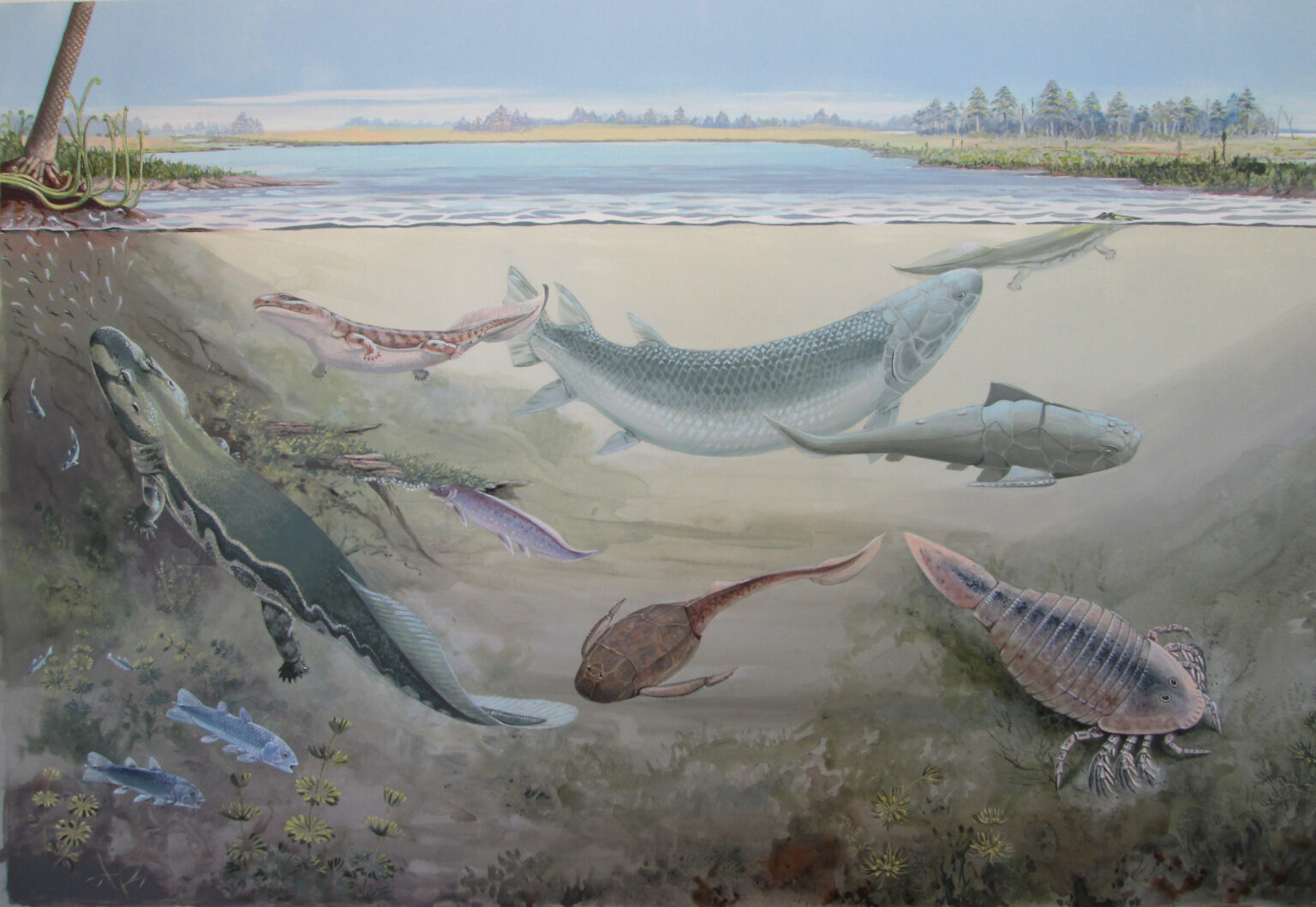By STEVEN LANG
At almost three metres long and with jaws to match, the biggest prehistoric bony fish ever described from southern Africa could eat basically whatever it wanted. It was the biggest predator in its ecosystem and it sometimes ate our distant ancestors, 360 million years ago.
Hyneria udlezinye is the subject of a new paper published by Dr Rob Gess and the Swedish expert on lobe-finned fish and tetrapods, Prof Per Ahlberg.
Hyneria udlezinye lurked in the waters of an estuary waiting for an unsuspecting tetrapod to swim by. Itwas too big to lie and wait in the shallowest waters where tetrapods enjoyed relative safety, but when prey crossed open waters there was opportunity. Hyneria had rows of sharp teeth and fangs to make short work of tetrapods, armour-plated fish, coelacanths and other creatures. The giant fish struck with lightning speed and it was over almost before it began.
That scene most likely played itself out many times in a palaeolagoon right here where Makhanda now stands. Remnants of Hyneria and other animals sank into mud at the bottom of the lagoon. Over millions of years, the mud was compressed as the ancient shoreline was folded into a huge mountain range in the area.
Mud, bones and scales became fossilised and altered as they were compacted up to 10 kms below the mountain tops. As conditions changed, time and weather wore the mountains down and their former roots rose, until layers of black shale were once again close to the surface.
In 1985, about 360 million years after vestiges of Hyneria fell to the bottom of a lagoon on the southern shore of Gondwana, the national roads authority of South Africa resolved to build a highway cutting through the hills of Waterloo Farm. Unexpectedly they disturbed the shale.
Then along came Rob Gess. At that time a high school pupil planning to study at Rhodes University – now an internationally renowned palaeontologist working from the Albany Museum in Makhanda.
Among the first fish fossils fragments he found tumbling down the slope in the mid-1980s were a number of distinctive looking scales. He showed them to Dr Norton Hiller, the palaeontologist in the Rhodes Geology Department. They knew that they were from a lobe-finned fish but were not sure which one.
Norton Hiller was intrigued by the trickle of fossils coming from Waterloo Farm, and after Gess had acquired a degree in Geology and Zoology, funded him to excavate at the site full time in the mid-nineties.
Gess painstakingly split the shale layers using very basic hand tools and a kitchen knife. Sometimes he found nothing at all; when he was luckier, a bone or scatter of bones; perhaps plates from an armour plated fish; a frond of seaweed, an ancient leaf or a scale from a fish that swam in those waters more than a hundred million years before the earliest dinosaurs evolved.
A few isolated bones came from the big mystery lobe finned fish.
Funding for his excavation dried up when Hiller emigrated in 1995 but he kept an eye out for new fossils as the slope deteriorated and started to collapse.
In 1999, the road was to be cut back and stabilised by the South African National Roads Agency, SANRAL, as it had become hazardous. Gess obtained the agency’s assistance with an ambitious project to save a large sample of shale for ongoing investigation. He and a team of workers hand-mined tens of tons of shale blocks and moved them to sheds out of the weather.
While systematically removing the blocks he got down to a layer where a lot of the scales had come from. Scattered across it were skull and shoulder bones from the big fish. Removed in big slabs these would later become the type specimen. Since then, going through the salvaged rocks he would find “a bone now and a bone another time – slowly accumulating bones, that we know were from the same kind of animal, have a similar ornamentation, and are always found associated with the same extremely distinctive fish scales”.
The process of finding the Hyneria bones was time consuming. It never seemed to be complete.
Then came the painstaking process of putting all the pieces together to form the head of the fish. Gess explained that the fossils come from animals of different sizes “so it’s quite a difficult jig-saw puzzle, but it’s possible to scale them all to the same size, using for example the distinctive thin portions around the edges where they overlapped each other, the pattern of sensory canals on the head, and what we know about closely related fish ”.
Ahlberg came to Makhanda to examine the fossils at the Albany Museum in person. He needed to have a first-hand perspective on the detailed structure of each piece and how it matched up with the others. Gess and Ahlberg worked together for two weeks, identifying each fragment, carefully documenting it with detailed drawings and working out where it fitted in the big picture. Gess later visited Ahlberg’s research facility at Uppsala University in Sweden where they finalised their work together using the drawings.
They were eventually able to assemble a set of bones including most of the skull and the whole of the shoulder girdle. Working long into the night together Gess and Ahlberg, aligned the bones in photoshop and made paper cut-outs that allowed them to fit the pieces of their jig-saw puzzle together in 3D.
Gess said that finally, 37 years after he found those first fish scales and wondered about the appearance of the fish that they came from, “We now have a very good idea of exactly what that fish would’ve looked like. So it’s been a long journey”.


